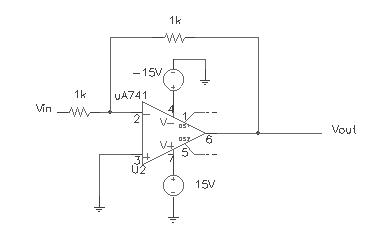|
Lab Exercise 12: The 741 Operational Amplifier
(There is no pre-lab for this exercise) In this lab, you will design and build several operational amplifier circuits on the breadboard.
Figure 1: The 741 Op-Amp Use -Vcc = -15V and +Vcc = +15V for all circuits. 1. Assume that Vin = 5V. Calculate Vout. Build
the circuit shown in Figure 2 (inverting op-amp) on the protoboard. After
your wiring has been checked by a lab assistant, apply a 5 volt input voltage.
Measure and record Vout. Is this the value you expected to see? How close
was your answer to your calculated result (do a percent difference).
Figure 2: Inverting Configuration 2. For the circuit in Figure 3 (non-inverting op-amp), assume Vin = 5V. Calculate Vout. Build the circuit shown in the figure. Apply a 5 volt input voltage. Measure and record Vout. Is this the value you expected to get? How close is it to your expected value (percent difference)?
Figure 3: Non-inverting Configuration 3. For the above problems (1 and 2), what is the highest and lowest input voltages you could apply to each circuit before the op-amp would "rail" (saturate)? 4. Design and build a cascaded op-amp circuit with a total gain of +1/8 (Refer to your class notes for assistance, if necessary). Calculate Vout for this circuit if you were to apply a 5V input. Apply a 5 volt input signal and record Vout. How close is your result to what you ideally would get? 5. Design and build an op-amp circuit with a total gain of 3.25. Apply a 5 volt input signal and record Vout. Record your result for Vout. 6. Design and build an op-amp circuit with a total gain
of -3.25. Apply a 5 volt input signal and record Vout. Record your result
for Vout.
Questions 1. How could you design a circuit to provide a gain of 1/8 to an input signal without using an op-amp? 2. In problems 5 and 6, were your outputs 3.25 (or -3.25) times the magnitude or your inputs? Explain why or why not.
|


